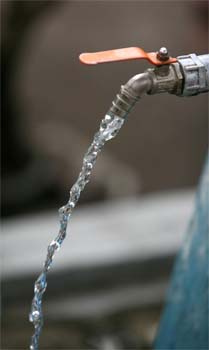Drinking water or potable water is water that is safe for ingestion, either when drunk directly in liquid form or consumed indirectly through food preparation. It is often (but not always) supplied through taps, in which case it is also called tap water. Typically in developed countries, tap water meets drinking water quality standards, even though only a small proportion is actually consumed or used in food preparation. Other typical uses for tap water include washing, toilets, and irrigation. Greywater may also be used for toilets or irrigation. Its use for irrigation however may be associated with risks.
The amount of drinking water required to maintain good health varies, and depends on physical activity level, age, health-related issues, and environmental conditions. For those who work in a hot climate, up to 16 litres (4.2 US gal) a day may be required.
Globally, by 2015, 89% of people had access to water from a source that is suitable for drinking – called improved water sources. In sub-Saharan Africa, access to potable water ranged from 40% to 80% of the population. Nearly 4.2 billion people worldwide had access to tap water, while another 2.4 billion had access to wells or public taps. The World Health Organization considers access to safe drinking-water a basic human right.
About 1 to 2 billion people lack safe drinking water. Water can carry vectors of disease. More people die from unsafe water than from war, then-U.N. secretary-general Ban Ki-moon said in 2010. Developing countries are most affected by unsafe drinking water.
